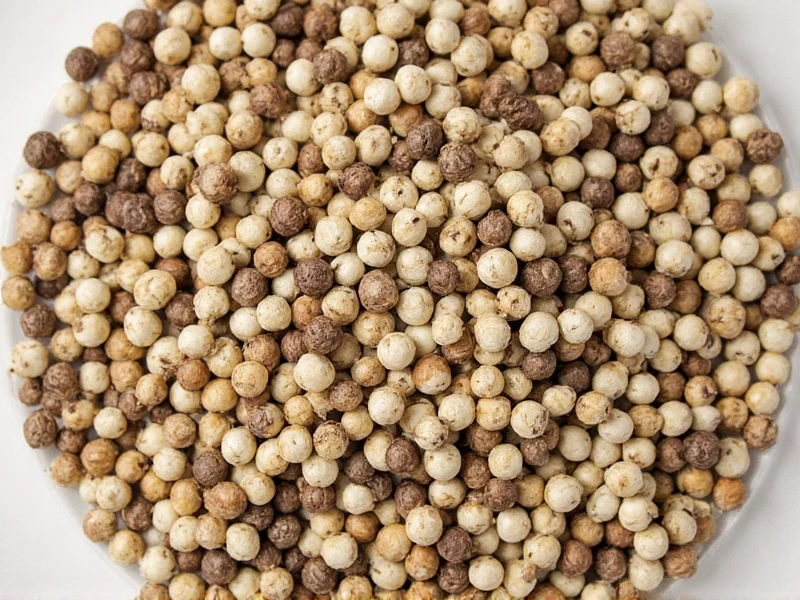Understanding when to use white pepper versus black pepper can significantly elevate your cooking. While both come from the same plant (Piper nigrum), their processing methods create distinct flavor profiles and visual characteristics that make each suitable for specific culinary applications. White pepper's subtle heat and earthy notes work best in particular dishes where black pepper would compromise either appearance or flavor balance.
Understanding White Pepper: Origins and Processing
White pepper originates from the same vine as black pepper, but undergoes different processing. While black peppercorns are dried with their outer fruit layer intact, white peppercorns have this layer removed through soaking and fermentation before drying. This process creates a spice with a cleaner appearance and a different flavor profile—less floral and citrusy than black pepper, with more earthy, musty notes and slightly less heat.
Key Differences Between White and Black Pepper
| Characteristic | White Pepper | Black Pepper |
|---|---|---|
| Processing Method | Ripe berries soaked to remove outer layer before drying | Unripe berries dried with outer layer intact |
| Flavor Profile | Earthy, musty, slightly fermented, milder heat | Sharp, floral, citrusy, more pronounced heat |
| Appearance | Tan to pale yellow, uniform color | Dark brown to black, visible flecks |
| Best Culinary Applications | Light-colored dishes, delicate sauces, certain Asian cuisines | Most savory dishes, grilled meats, robust sauces |
When to Use White Pepper: Specific Culinary Applications
1. Light-Colored Dishes and Sauces
This represents the most common reason for choosing white pepper over black pepper. When preparing dishes where visual presentation matters, white pepper provides seasoning without the dark specks that black pepper creates. Consider these specific applications:
- Cream sauces: Béchamel, Alfredo, and other white sauces where black pepper flecks would be visually distracting
- Light-colored soups: Consommé, vichyssoise, and other clear or pale soups
- Mayonnaise-based dressings: Such as aioli or remoulade where visual purity matters
- White fish preparations: Where the delicate appearance of the fish should remain pristine
2. Traditional Asian Cuisine
White pepper plays a significant role in many Asian culinary traditions, particularly in:
- Chinese cooking: Essential in many Cantonese dishes, hot and sour soup, and certain meat marinades
- Vietnamese cuisine: Used in pho broth and various dipping sauces
- Thai cooking: Features in some curry pastes and seafood dishes
- Korean dishes: Common in certain soups and stews where visual clarity matters
Professional chefs specializing in Asian cuisine often maintain that white pepper provides the authentic flavor profile expected in these traditional dishes.
3. Delicate Flavor Profiles
When creating dishes with subtle flavors that could be overwhelmed by black pepper's sharper notes, white pepper offers a more integrated seasoning. This makes it ideal for:
- Egg dishes: Especially in quiches, custards, and delicate omelets
- Seafood preparations: Where the natural flavors should shine through
- Light vegetable dishes: Such as asparagus, cauliflower, or artichokes
- Chicken or veal piccata: Where lemon and capers dominate the flavor profile
When Not to Use White Pepper
Understanding when not to use white pepper is equally important for culinary success. Avoid white pepper in these situations:
- Robust meat dishes: Steak, burgers, and hearty stews benefit from black pepper's stronger flavor
- Grilled foods: The charred appearance complements black pepper's visual aesthetic
- Dark sauces: Gravies, demi-glace, and brown sauces where appearance isn't compromised
- Dishes requiring pronounced pepper flavor: When you want that distinctive pepper "kick"
Selecting and Storing White Pepper
For optimal flavor when using white pepper, follow these guidelines:
- Buy whole peppercorns: Pre-ground white pepper loses flavor quickly; grinding just before use preserves maximum flavor
- Check for freshness: Fresh white peppercorns should have a clean, earthy aroma without mustiness
- Store properly: Keep in an airtight container away from light and heat to maintain potency
- Consider origin: Vietnamese and Chinese white pepper tends to have the cleanest flavor profiles
White Pepper in Professional Kitchens
Professional chefs maintain specific guidelines for when to use white pepper in restaurant settings. Many fine dining establishments keep both white and black pepper on hand specifically for their different applications. The decision often comes down to whether visual presentation or flavor intensity takes priority in a particular dish. Culinary schools teach that understanding these subtle distinctions separates amateur cooking from professional-level technique.
Common Misconceptions About White Pepper
Several myths persist about white pepper that affect when to use white pepper properly:
- "White pepper is milder in heat": Actually, white pepper often contains slightly more piperine (the compound responsible for heat) than black pepper, but its flavor profile makes the heat feel different
- "White pepper is just bleached black pepper": Proper white pepper undergoes natural fermentation to remove the outer layer, not chemical bleaching
- "All white pepper tastes the same": Like wine, white pepper flavor varies by origin, harvest time, and processing method
Conclusion
Knowing when to use white pepper properly enhances both the visual presentation and flavor balance of your dishes. While black pepper remains the versatile workhorse of the spice cabinet, white pepper serves specific culinary purposes that black pepper cannot replicate. By understanding the distinct applications for white pepper—particularly in light-colored dishes, certain Asian cuisines, and delicate flavor profiles—you'll expand your seasoning repertoire and achieve more professional cooking results. The next time you're preparing a creamy sauce or authentic Chinese soup, reach for white pepper to elevate both appearance and taste.











 浙公网安备
33010002000092号
浙公网安备
33010002000092号 浙B2-20120091-4
浙B2-20120091-4